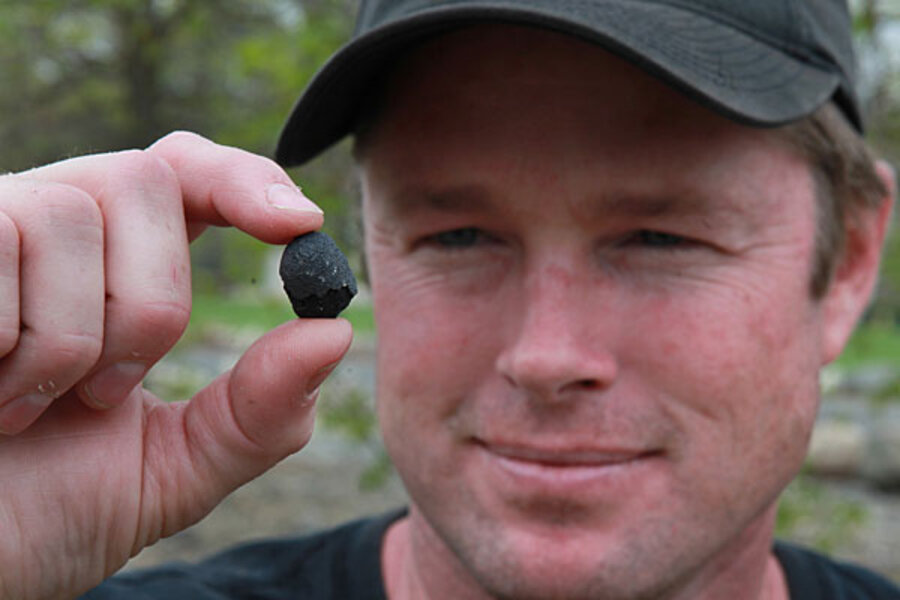California fireball produces jackpot for meteorite hunters
| Reno, Nevada
Robert Ward has been hunting and collecting meteorites for more than 20 years, so he knew he'd found something special in the Sierra foothills along the path of a flaming fireball that shook parts of Northern California and Nevada with a sonic boom over the weekend.
And scientists have confirmed his suspicions: it's one of the more primitive types of space rocks out there, dating to the early formation of the solar system 4 to 5 billion years ago.
"It was just, needless to say, a thrilling moment," Ward of Prescott, Ariz., told The Associated Press in a telephone interview Wednesday as he walked through an old cemetery in search of more meteorites about 35 miles northeast of Sacramento.
He found the first piece on Tuesday along a road between a baseball field and park on the edge of Lotus near Coloma, where James W. Marshall first discovered gold in California, at Sutter's Mill in 1848.
Ward, who has found meteorites in every continent but Antarctica and goes by "AstroBob" on his website, said he "instantly knew" it was a rare meteorite known as "CM" — carbonaceous chondrite — based in part on the "fusion crusts from atmospheric entry" on one side of the rock.
RECOMMENDED: Are you scientifically literate? Take the quiz
"It is one of the oldest things known to man and one of the rarest types of meteorites there is," he said. "It contains amino acids and organic compounds that are extremely important to science."
Ward actually has two rocks but suspects they were part of the same small meteorite that broke on impact. Each weighs about 10 grams — about the same as two nickels. He said his only previous finds that rival this one were three lunar meteorites he found years ago in the Middle East.
Experts say the flaming meteor was probably about the size of a minivan when it entered the Earth's atmosphere with a loud boom and about one-third of the explosive force of the atomic bomb. It was seen from Sacramento, Calif., to Las Vegas and parts of northern Nevada.
An event of that size might happen once a year around the world, said Don Yeomans of NASA's Near-Earth Object Program Office at the Jet Propulsion Laboratory in Pasadena, Calif. "But most of them occur over the ocean or an uninhabited area, he said.
"Getting to see one is something special," he said. He added, "most meteors you see in the night's sky are the size of tiny stones or even grains of sand, and their trail lasts all of a second or two."
The meteor probably weighed about 154,300 pounds, said Bill Cooke, a specialist in meteors at NASA's Marshall Space Flight Center in Huntsville, Ala. At the time of disintegration, he said, it probably released energy equivalent to a 5-kiloton explosion — the Hiroshima bomb was 15 kilotons.
"You don't often have kiloton rocks flying over your head," he said.
The boom, another expert said, was caused by the speed with which the space rock entered the atmosphere. Meteorites enter Earth's upper atmosphere at somewhere between 22,000 mph and 44,000 mph — faster than the speed of sound, thus creating a sonic boom.
The friction between the rock and the air is so intense that "it doesn't even burn it up, it vaporizes," said Tim Spahr, director of the Minor Planet Center at Harvard University.
John T. Wasson, a longtime professor and expert in meteorites at UCLA's Institute of Geophysics and Planetary Physics, said he understood that in addition to Lotus, another small meteorite had been in nearby Coloma,
Bits of the meteor could be strewn over an area as long as 10 miles, most likely stretching west from Coloma, he said.
"I'm sure more will be found, I'm hoping, including some fairly big pieces," Wasson said. "The fact that two pieces already have been found means one knows where to look."
Wasson suspected hundreds of dealers and collectors already have joined the search. He said it was important to recover the meteorites soon because any rain will cause them to degrade, losing their sodium and potassium.
"From my viewpoint as a meteorite researcher," he said, "I'm hopeful some big pieces are found right away."
Yeomens confirmed this type of meteorite is one of the oldest, dating to the origin of the solar system 4 to 5 billion years ago. And it's "actually kind of unusual," he said.
Yeomens said it's got two of the most important chemicals that scientists look for: carbon and a form of water. In fact, this type of space rock is likely full of water and would have made a good candidate for the new space company announced Tuesday that plans to mine asteroids, he said.
"And this one landed in their backyard for a lot less than they planned to spend," he said.
The mini-van sized asteroid wasn't on NASA's lengthy list of near Earth objects that they track coming close to the planet, so it took scientists by surprise. "There are millions of objects of that size that we don't know about," he said. "They're too small to image unless they're right up on top of you."
___
AP Science Writer Seth Borenstein contributed to this story from Washington, D.C.
Copyright 2012 The Associated Press.








